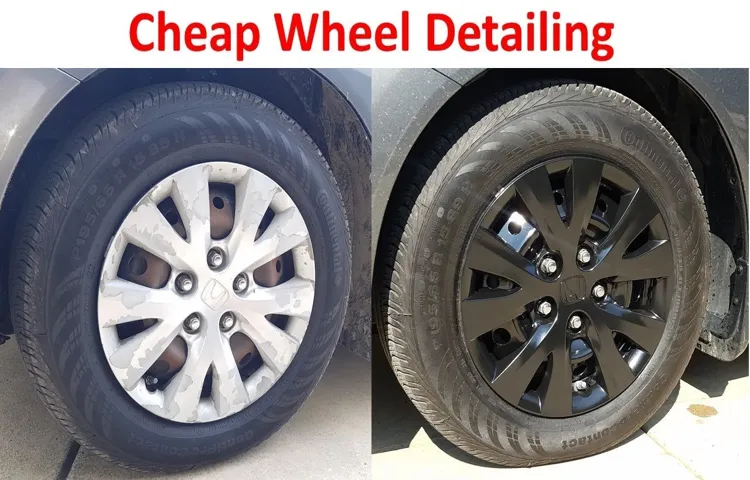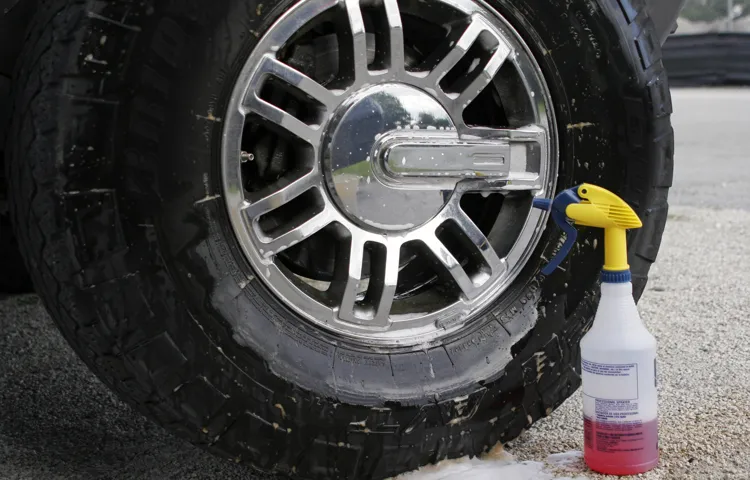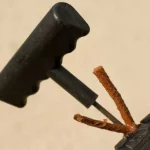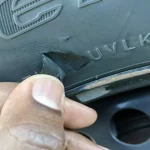Are you tired of seeing your tire rims covered in unsightly rust? Rust can accumulate quickly on tire rims, and it not only decreases the overall appearance of your vehicle but can also lead to damage over time. Fortunately, removing rust from tire rims is easier than you may think. With the right tools and techniques, you can restore your tire rims to their former glory and give your vehicle the sleek look it deserves.
In this blog post, we’ll explore simple yet effective ways to remove rust from tire rims, so you can drive with confidence and style.
Table of Contents
- 1 Why You Need to Remove Rust
- 2 Materials You will Need to Remove Rust
- 3 Step-by-Step Process
- 3.1 Clean the rims with soap and water before starting rust removal
- 3.2 Use the wire brush to loosen any large rust spots
- 3.3 Apply the rust remover solution as directed
- 3.4 Saturate the affected areas with vinegar or baking soda and wait
- 3.5 Use steel wool or sandpaper to buff the area to a polished finish
- 3.6 Rinse the rims with water and dry completely
- 4 Preventing Future Rust
- 5 Conclusion
- 6 FAQs
Why You Need to Remove Rust
Are you tired of seeing rust on your tire rims? It’s not just an eyesore, it can actually be dangerous. Rust weakens the structure of the rims and can cause them to fail while driving. If you notice rust forming, it’s important to remove it as soon as possible.
So, how to get rust off tire rims? There are a few methods you can try. One option is to use a wire brush or sandpaper to scrub away the rust manually. Another option is to use a chemical rust remover.
Whichever method you choose, be sure to wear gloves and eye protection to avoid injury. Don’t let rust damage your rims any further – take action now and protect your safety on the road.
Corrosion can spread to other parts of the tire, leading to damage
Corrosion is not just unsightly and unpleasant to look at, it can also cause serious damage to your tire. When rust forms on the surface of the tire, it can weaken the metal and make it more susceptible to cracking or breaking. This can lead to a blowout while driving, which is extremely dangerous.
In addition, corrosion can spread to other parts of the tire, such as the rim or hub, and cause further damage. It’s important to remove rust as soon as you notice it to prevent it from getting worse and causing more serious problems down the road. By doing so, you’ll not only improve the appearance of your tire but also ensure that it remains safe and reliable.
So don’t delay – take action now to remove any rust or corrosion that you see on your tire. Your safety is worth it.

It can also cause the rim to weaken and potentially crack or break
As a bike owner, it is crucial to take care of your bike to ensure it remains in the best condition. One of the things you need to be particularly aware of is rust. Rust can quickly eat away at metal and cause it to weaken, which can compromise the safety and functionality of your bike.
If left untreated, rust can also cause the rim to weaken and potentially crack or break. Removing rust from your bike is essential to avoid risking any accidents due to structural damage. Not to mention, a rust-free bike simply looks better and performs better.
So, if you want to keep your bike in top condition, it’s best to remove rust as soon as you see it forming. Spray some WD40, apply some vinegar or lemon juice, and give it a good scrub to ensure it’s completely removed. Stay on top of rust prevention, and you’ll be able to enjoy your bike for longer without worrying about any safety hazards.
Materials You will Need to Remove Rust
Have you noticed rust build-up on your tire rims that are ruining the look of your car? It’s a common issue for car owners, but luckily, it’s a problem that can be fixed easily with the right materials. To remove rust from your tire rims, you’ll need a few key items. First, get your hands on a wire brush or sandpaper that is abrasive enough to take off the rust on the rims.
You can also use a rust remover or naval jelly, which you can find at most hardware stores. Additionally, you’ll need a clean cloth and a mild detergent to wash your rims down afterward to prevent rust from coming back. With these materials in hand, you’ll be ready to bring your rims back to their former glory.
Remember to take your time and be gentle to prevent scratches or damage to your car’s wheels. By following these simple steps, you can get rid of unsightly rust stains and keep your rims looking new.
Gloves and safety goggles
When it comes to removing rust, you’ll need a few materials to make the process go smoothly. Two of the most important items you’ll need are gloves and safety goggles. Rust removal often involves harsh chemicals, which can be harmful if they come into contact with your skin or eyes.
That’s why protective gear is a must-have. Gloves will not only protect your skin from the chemicals, but also from sharp edges or rough surfaces. Meanwhile, safety goggles will keep your eyes safe from splashes or sprays of chemicals.
Don’t underestimate the importance of protecting yourself during the rust removal process. With gloves and safety goggles, you can complete the task with confidence and without risk of injury.
Wire brush for initial removal
“wire brush for rust removal” If you’ve got rusty metal that needs a makeover, there are a few materials you’ll need to get started. A wire brush is an excellent tool for removing rust from metal surfaces before applying any other solutions or coatings. Use a wire brush to scrub away the rust, taking care to get into all the nooks and crannies.
You can also use a power tool like a drill with a wire brush attachment for larger surfaces. This initial removal step is crucial for a successful rust removal process. Not only does it clear away the rust, but it also creates an ideal surface for subsequent treatments to adhere to.
When using a wire brush, be sure to wear gloves and safety glasses to protect your skin and eyes. With a little elbow grease and the right tools, you’ll have your metal looking like new in no time!
Steel wool or sandpaper for fine sanding
When it comes to removing rust, you’ll need a few key materials to get the job done right. One important consideration is whether to use steel wool or sandpaper for fine sanding. Both can be effective, but it really depends on the type and extent of rust you’re dealing with.
Steel wool is a great option for removing rust from larger surfaces or for heavy-duty cleaning, with the added benefit of being able to get into tight corners and crevices. If you’re looking for a smoother finish, however, sandpaper may be the better choice, especially for more delicate surfaces. Whatever your preference, make sure you’re using the appropriate grit for the job and taking all necessary safety precautions, such as wearing gloves and eye protection.
By following these steps, your rust removal project is sure to be a success and your belongings will be looking as good as new in no time!
Rust remover or home remedies like vinegar or baking soda
If you’re dealing with rust on metal surfaces, the good news is that it’s possible to remove it with a few basic materials. You can either opt for rust remover products available in the market or try out some home remedies like vinegar or baking soda. To use rust remover products, you should first clean the rusted surface with a wire brush or sandpaper.
Next, apply the rust remover solution following the instructions on the product label. You can then scrub the area lightly with a wire brush before rinsing it with water. For home remedies, mix equal parts of vinegar and water or baking soda and water to create a paste.
Then apply the paste to the rusted surface and let it sit for a few hours before scrubbing with a toothbrush or wire brush. After scrubbing, rinse the surface with water and repeat the process if necessary. Remember, it’s important to wear gloves and safety goggles when working with rust remover products or home remedies.
With a little effort and the right materials, you can remove rust from almost any metal surface and restore it to its former glory.
Step-by-Step Process
If you’re tired of seeing those unsightly rust stains on your tire rims every time you go out for a drive, the good news is that you can get rid of them yourself with just a few simple tools and techniques. To start, make sure to thoroughly wash your rims with soap and water to remove any dirt or debris. Then, use a rust dissolver solution and a stiff-bristled brush to scrub away the rust.
You can also try using a mixture of baking soda and water to create a paste that can be applied directly to the affected areas. Once you’ve finished removing the rust, rinse your rims with water and dry them off completely to prevent any new rust from forming. Don’t forget to protect your freshly cleaned rims by applying a coat of wax or sealant, as this will help keep them looking shiny and new for longer.
With a little bit of elbow grease and the right tools, getting rid of rust on your tire rims is easier than you might think!
Clean the rims with soap and water before starting rust removal
If your rims are starting to rust, don’t panic. There’s a simple solution to removing rust from rims and restoring them to their former glory. Before starting any rust removal process, it’s essential to clean the rims with soap and water thoroughly.
This initial step helps remove any dirt or debris that might be covering the rust, making it easier to identify and remove. Once you’ve cleaned the rims, let them dry off completely before proceeding to the next step. Skipping this crucial step can lead to uneven results and possibly damage the wheels’ finish, so don’t rush it.
To remove rust from rims, you’ll need a rust remover spray or a rust removal paste. Before applying either of them, ensure that you cover the tires and any nearby areas with plastic to avoid staining. Then, you can apply the rust remover using a brush, sponge, or cloth, depending on the product’s instructions.
Be sure to wear safety gloves and eye protection when handling any rust removal products. Once you’ve applied the rust remover, let it sit for the recommended amount of time, usually between 10-20 minutes, and don’t let it dry up. After the recommended time has passed, scrub the rust off gently using a wire brush or a scouring pad, and don’t apply too much force to avoid scratching the rims.
It’s essential to work on one section at a time and rinse the area off with water immediately after scrubbing it clean. After you’ve completed the entire rim, rinse everything with water to ensure all traces of rust remover have been removed. In conclusion, cleaning the rims before starting rust removal is a crucial step in the process, ensuring the rust removal is more successful and doesn’t damage your wheels’ finish.
Take the time to do it correctly, and the results will speak for themselves. With patience, a little elbow grease, and the right rust remover product, your rims will be rust-free and looking as good as new again.
Use the wire brush to loosen any large rust spots
When it comes to restoring a metal surface that’s been affected by rust, the process involves several stages. One of the first steps you need to take is to use a wire brush to loosen any large spots of rust. The wire brush serves to remove the loose rust bits from the surface of the metal.
By exposing the underlying metal, you can assess where the rust has damaged the metal and prepare it for the next stage of restoration. Depending on the severity of the rust, you may need to use a power tool to scrape off the rust build-up. However, it’s important to be careful not to damage the metal while removing the rust and to wear protective gear to reduce exposure to rust particles.
Ultimately, the key to restoring a rusted metal surface is to take a diligent and careful approach, one step at a time.
Apply the rust remover solution as directed
When it comes to removing rust from metal surfaces, applying a rust remover solution is a crucial step. Before using the solution, be sure to prepare the area by cleaning and drying it thoroughly. Once the surface is ready, follow the directions on the rust remover solution carefully.
Typically, this involves applying the solution to the rusted area and letting it sit for a specific amount of time, depending on the product’s instructions. It’s essential to wear protective gloves and work in a well-ventilated area when using the solution. After the recommended time has passed, use a brush or scrub pad to remove the residue and scrub away any remaining rust.
Finally, rinse the area with water and dry it off completely. Remember that using the rust remover solution improperly can damage the surface, so following the instructions is crucial for a successful outcome. With the right preparation and attention to detail, you’ll be able to remove rust from your metal surfaces effectively.
Saturate the affected areas with vinegar or baking soda and wait
Saturating the affected areas with vinegar or baking soda can be an effective solution when dealing with tough stains. The process is quite simple and only requires a few household items. To begin, identify the affected areas and prepare a solution of either vinegar or baking soda mixed with water.
Once mixed, apply the solution generously to the stain and let it sit for at least 20 minutes. This allows the solution to deeply penetrate the stain and break down any buildup or residue. After the wait time is up, use a brush or cloth to gently scrub the area, removing any remaining residue.
Rinse the area thoroughly with water and repeat the process if necessary. The acidity in the vinegar or baking soda helps to neutralize stains, while also being gentle on delicate fabrics and surfaces. With a little patience and determination, you can easily tackle even the toughest stains using this method.
So next time you’re faced with a stubborn stain, give this simple yet effective technique a try!
Use steel wool or sandpaper to buff the area to a polished finish
If you want to bring a polished finish to an area, steel wool or sandpaper can help you achieve that smooth surface you’re after. Follow these easy steps to get a shiny and polished finish: Start by cleaning the surface area with soap and water to remove any dirt or grime.
Dry the area thoroughly before beginning to work.
Use fine-grit sandpaper or steel wool with a gentle touch to buff the surface, moving in a circular motion. Add a little pressure as you go along if you need to remove deeper scratches or marks.
Once you have buffed the area, wipe it down with a clean cloth to remove any remaining residue.
Finish by applying a coat of polish or wax for added protection and luster. Remember, these materials can be abrasive, so be sure to use caution and avoid scrubbing too hard or for too long in one area. With a little elbow grease and patience, you’ll have a smoothly polished area in no time!
Rinse the rims with water and dry completely
When it comes to keeping your rims looking pristine, it’s important to give them a thorough rinse and dry. Start by hosing down your rims with water, making sure to cover every inch. If you’re dealing with stubborn dirt or grime, you may want to use a specialized cleaner to break it down.
Once you’ve fully rinsed your rims, it’s time to dry them off completely. Whether you’re using a towel or air drying, make sure to remove all of the moisture from the rims. Failure to do so could result in water spots or rusting.
By taking the time to rinse and dry your rims properly, you’re ensuring that they’ll continue to look their best for years to come. So don’t skip this step, your rims will thank you! As a bonus, by rinsing your rims regularly, you’ll also reduce the risk of brake dust buildup, which can cause corrosion and damage to your rims over time. Remember, regular maintenance is key to keeping your car looking and running great!
Preventing Future Rust
If you want to prevent future rust on your tire rims, there are a few simple steps you can take. First, make sure to clean your rims regularly using a mild detergent and water. This will help remove any dirt or debris that can lead to rust formation.
You can also apply a protective coating to your rims, such as a wax or sealant, which will help keep moisture and other contaminants from causing rust to form. Another way to prevent rust is to avoid driving your vehicle in areas where it may be exposed to harsh weather conditions or salty roads. This can include coastal regions or areas where road salt is commonly used during the winter months.
By taking these steps to prevent rust, you can help keep your tire rims looking great for years to come, and avoid costly repairs or replacements in the future. And if you do need to remove rust from your rims, using a specialized cleaner and a bit of elbow grease can be an effective solution.
Wash the rims frequently to prevent buildup of dirt and debris
One of the most effective ways to prevent future rust on your car’s rims is to make sure you clean them frequently. Regularly washing your rims will help to remove dirt, debris, and other buildup that can lead to rust over time. If you live in an area with harsh weather conditions or are frequently driving on rough terrain, it’s even more important to maintain clean rims.
This will help prevent any potential damage that could lead to rust or other issues. Additionally, taking the time to dry your rims thoroughly after each wash can help prevent any moisture buildup that could contribute to rust formation. By keeping an eye on the condition of your rims and taking steps to maintain them regularly, you can help ensure that your car stays rust-free and looks great for years to come.
So, make sure to add “washing the rims” to your car maintenance checklist and stay on top of it!
Apply a rust inhibitor after cleaning
If you want to prevent future rust from forming on your metal surfaces, you should apply a rust inhibitor after cleaning. A rust inhibitor is a chemical or a coating that is designed to prevent rust from occurring or spreading. It works by creating a protective barrier on the surface of the metal which keeps moisture and oxygen away, the main culprits behind rust formation.
An important thing to consider when using a rust inhibitor is to read the instructions carefully. Different types of inhibitors require different methods of application, so be sure to follow the manufacturer’s directions to get the best results. Spray-on inhibitors are easy to use, but you may need to use a brush or a cloth to ensure complete coverage.
Another important factor to consider is the environment your metal surfaces are exposed to. If they are exposed to harsh weather conditions or chemicals, you may need to reapply the inhibitor more frequently to ensure maximum protection. Overall, applying a rust inhibitor after cleaning is a simple and effective way to prevent future rust from forming on your metal surfaces.
It’s important to choose the right inhibitor for the job and to properly apply it according to the instructions. By doing so, you’ll save yourself time and money in the long run by avoiding costly repairs or replacements.
Consider using a protective coating for the rims
If you’re looking to prevent future rust on your rims, consider using a protective coating. Applying a layer of protective coating can help to seal off the metal from moisture and prevent oxidation from occurring. This can help to prolong the life of your rims and keep them looking as good as when you first bought them.
There are a variety of coatings available on the market, including ceramic coatings, clear coats, and sealants. Some coatings may require more frequent reapplication than others, so it’s important to do your research and choose the right one for you. Though it may require some extra effort upfront, investing in a protective coating can save you money and hassle in the long run by preventing rust and corrosion.
So, give your rims the protection they need and enjoy smooth and safe rides for years to come.
Conclusion
Well folks, there you have it – getting rust off tire rims is no longer a mystery! With a bit of elbow grease, some household items, and a willingness to get your hands dirty, you can have those rims looking as shiny and new as the day you bought them. And remember, if all else fails, you can always just embrace the rust and pretend it’s a stylish vintage look.”
FAQs
What causes rust on tire rims?
Rust on tire rims is caused by the metal reacting with moisture and oxygen in the air, leading to oxidation. Salt from winter roads can also contribute to rust formation.
Can rust on tire rims be prevented?
Yes, regularly cleaning and drying your rims, avoiding driving on salted roads, and applying a protective coating can all help prevent rust formation on tire rims.
Is it safe to drive with rusty tire rims?
While it is generally safe to drive with rusty tire rims, the rust can weaken the metal over time, eventually leading to tire failure. It is best to address rust as soon as it is noticed.
How can I remove rust from tire rims?
There are several methods for removing rust from tire rims including using a rust remover solution, baking soda and water paste, white vinegar, or lemon juice and salt. It is important to thoroughly clean and dry the rims afterwards.
Can I paint over rust on my tire rims?
While it is possible to paint over rust on tire rims, it is important to remove as much rust as possible and prepare the surface properly before painting for a smooth and long-lasting finish.
Do I need to replace my tire rims if they are rusty?
In most cases, tire rims do not need to be replaced due to rust alone. However, if the rust has caused significant structural damage or weakened the metal, it may be necessary to replace the rims.
What should I do if my tire rims continue to rust despite preventative measures?
If rust continues to form on your tire rims despite preventative measures, it may be a sign of a larger issue such as a structural defect or improperly sealed coating. It is best to have a professional inspect and repair or replace the rims as necessary.



